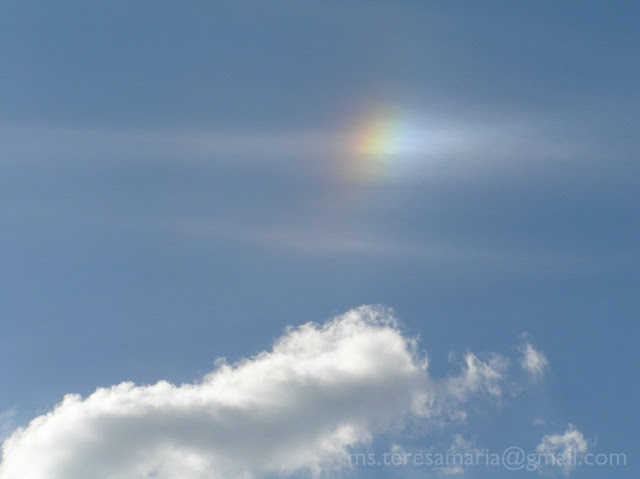Despite
the slow onset, we now have a proper winter, although milder than average. The
weather has been a bit colder and frost and clearer skies generally go hand in hand. So we’ve
been fortunate enough to witness an atmospheric phenomenon we had almost forgotten: we have
seen some actual daylight. Of course, you need to be alert to spot the sun
itself but now that it rises just a little bit above the rooftop of our old cow
house there may be a chance even for me if I’m really lucky.
The other day, we were driving southward at around the time (3:15 pm) the sun was
starting to set and saw the above rainbow-coloured halo on both sides of the
sun. I’m always carrying my camera these days so we stopped for a while and I
was able to capture this fascinating optical phenomenon, which is created when the
sun (or moon) is shining through ice crystals in thin clouds.
We once observed a short spectrum-coloured stretch of a halo in the
summertime in broad daylight but we had never witnessed this with the setting
sun so I had to find out more about halos. I learned that they are, in fact,
even more common than rainbows although many people have never noticed one.
This is because halos are often formed so close to the sun that it is
impossible to distinguish them with the naked eye.
 |
| A halo in full summer daylight. |
Earlier this week the news reported that a massive sun storm would start colliding with the Earth's magnetic field and northern lights might be visible not only in the polar region but probably even as far south as in the UK. A location away from any artificial light, such as our place in the country, is the most ideal for viewing the aurora but now the sky was completely covered by clouds and there was nothing to be seen.
Some years ago I did see a fantastic display of northern lights here in Southern Finland but only because my daughter happened to take the dog out after midnight and fetched me to see them. This week the skies were clear mainly in the more northern regions and the auroras may have looked something like the spectacular ones on this striking video shot last year in Finnish Lapland. What a wonder!
 |
| Our regular sunset these days. |


No comments:
Post a Comment